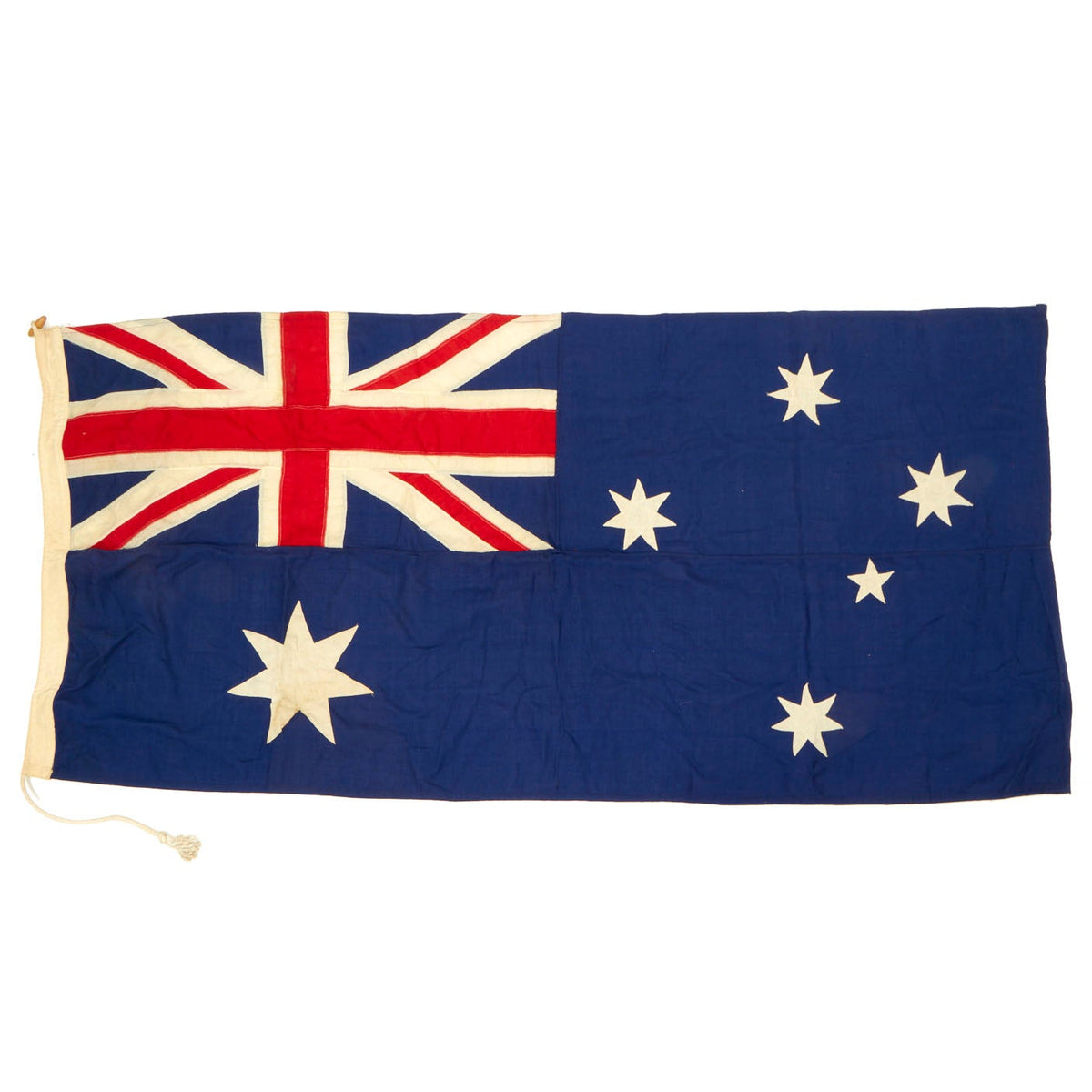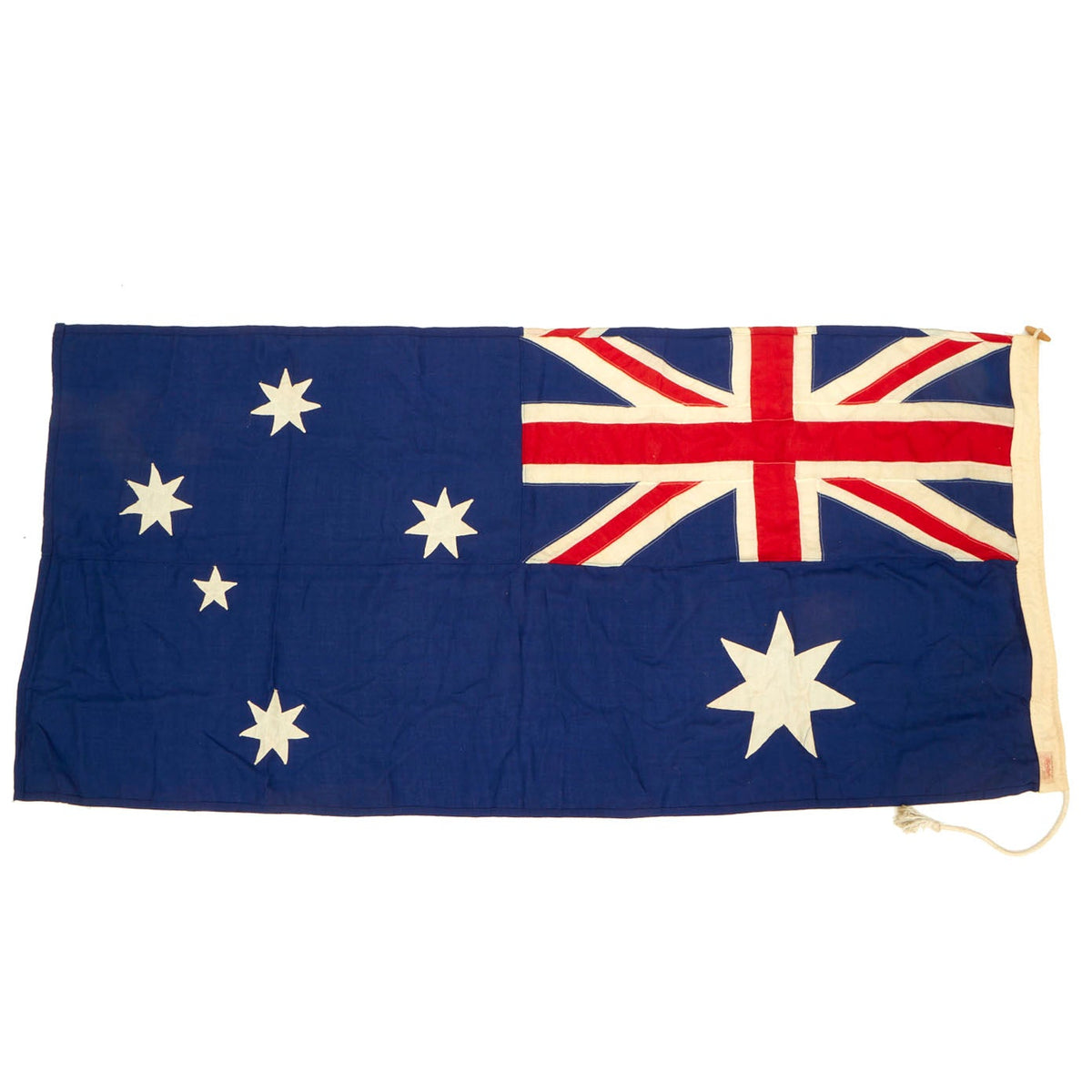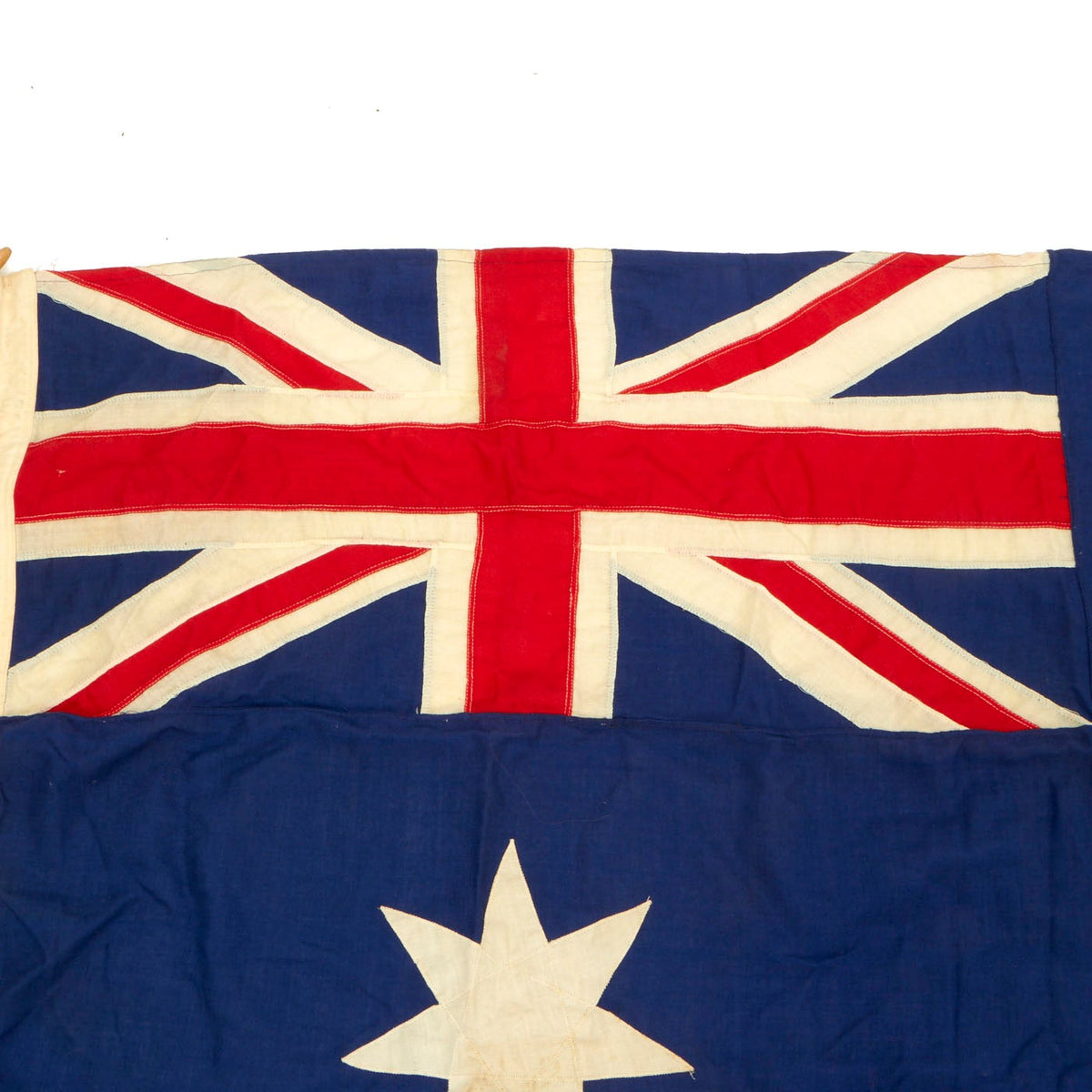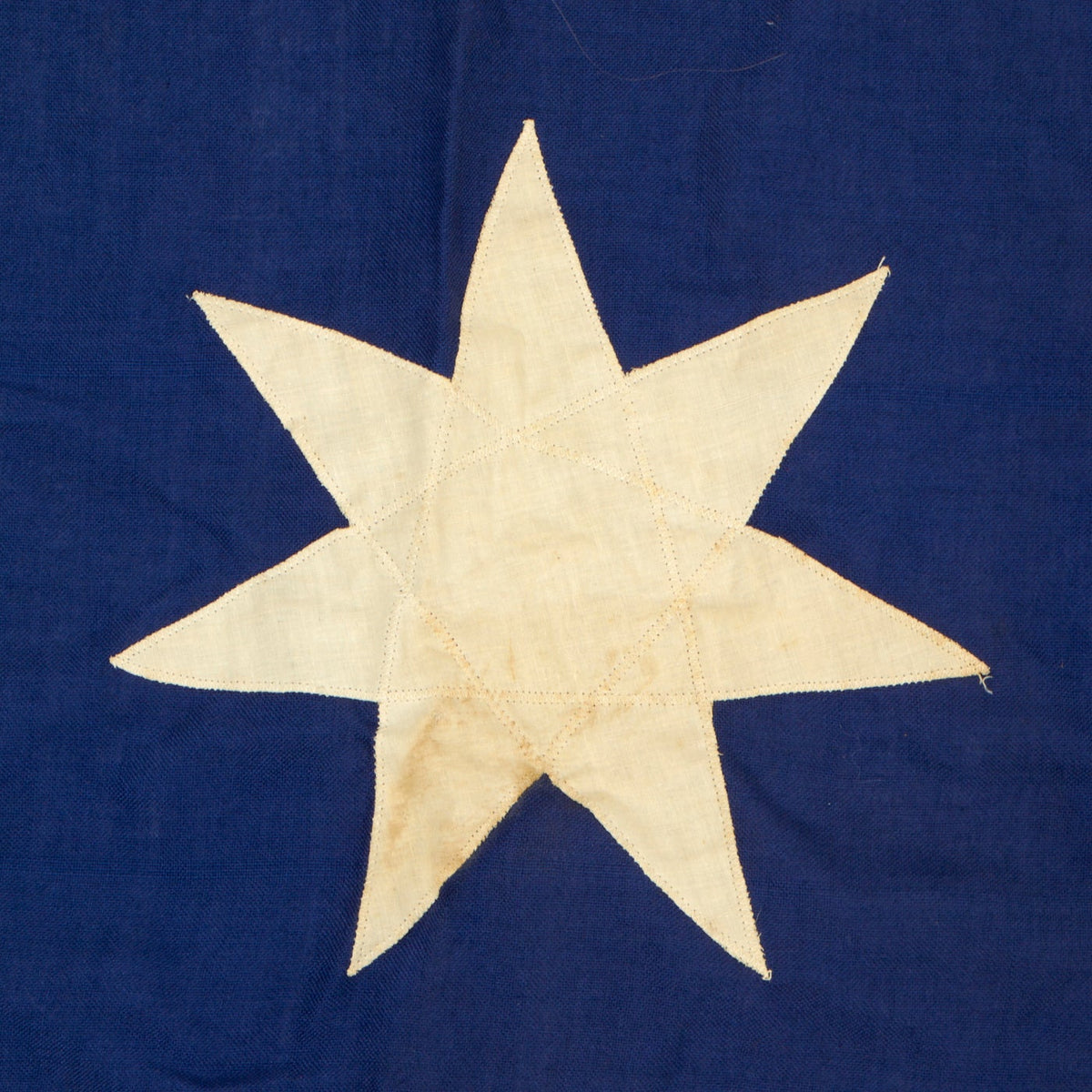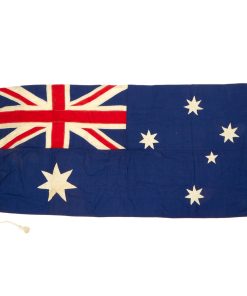Original Australian WWII Era Applique Large Heavy Cotton Flag by Smith Copeland & Co – 33″ x 71″ Original Items
$ 295,00 $ 118,00
Original Item: Only One Available. This large flag is the ‘Excelsior’ heavy cotton flag and is complete with wooden securing toggle. There is a minor amount of staining on the large white 7 point star stain, though more importantly, the overall condition is very good, there are no tears or holes and the colors are still very vivid.
The flag of Australia is a defaced Blue Ensign; a blue field with the Union Flag in the canton, and a large white seven-pointed star known as the Commonwealth Star in the lower hoist quarter. The fly contains a representation of the Southern Cross constellation, made up of five white stars – one small five-pointed star and four, larger, seven-pointed stars.
The flag still has the manufacturers label present on the hoist side header:
SMITH COPELAND & Co PTY LTD
Aberdeen
Trade Mark
Phone 51 5044
10-24 VINCENT ST. MARRICKVILLE
The flag measures in at 71in long and 33in high, and is in very good condition, having been well taken care of. Ready for display or to fly outside your station!
History of Australia’s Flag
The flag of Australia is based on the British Blue Ensign—a blue field with the Union Jack in the upper hoist quarter—augmented with a large white seven-pointed star (the Commonwealth Star) and a representation of the Southern Cross constellation, made up of five white stars (one small five-pointed star and four, larger, seven-pointed stars). There are other official flags representing Australia, its people and core functions of government.
The flag’s original design (with a six-pointed Commonwealth Star) was chosen in 1901 from entries in a competition held following the Federation, and was first flown in Melbourne on 3 September 1901, the date proclaimed as Australian National Flag Day. A slightly different design was approved by King Edward VII in 1903. The current seven-pointed Commonwealth Star version was introduced by a proclamation dated 8 December 1908. The dimensions were formally gazetted in 1934, and in 1954 the flag became recognised by, and legally defined in, the Flags Act 1953, as the Australian National Flag.
Australia During WWII
Australia entered World War II on 3 September 1939, following the government’s acceptance of the United Kingdom’s declaration of war on Germany. Australia later entered into a state of war with other members of the Axis powers, including the Kingdom of Italy on 11 June 1940, and the Empire of Japan on 9 December 1941. By the end of the war, almost a million Australians had served in the armed forces, whose military units fought primarily in the European theatre, North African campaign, and the South West Pacific theatre. In addition, Australia came under direct attack for the first time in its post-colonial history. Its casualties from enemy action during the war were 27,073 killed and 23,477 wounded. Many more suffered from tropical disease, hunger, and harsh conditions in captivity: of the 21,467 Australian prisoners taken by the Japanese only 14,000 survived.
Australian Army units were gradually withdrawn from the Mediterranean and Europe following the outbreak of war with Japan. However, Royal Australian Air Force and Royal Australian Navy units and personnel continued to take part in the war against Germany and Italy. From 1942 until early 1944, Australian forces played a key role in the Pacific War, making up the majority of Allied strength throughout much of the fighting in the South West Pacific theatre. While the military was largely relegated to subsidiary fronts from mid-1944, it continued offensive operations against the Japanese until the war ended.
World War II contributed to major changes in the nation’s economy, military and foreign policy. The war accelerated the process of industrialisation, led to the development of a larger peacetime military and began the process with which Australia shifted the focus of its foreign policy from Britain to the United States. The final effects of the war also contributed to the development of a more diverse and cosmopolitan Australian society.
Fast Shipping with Professional Packaging
Thanks to our longstanding association with UPS FedEx DHL, and other major international carriers, we are able to provide a range of shipping options. Our warehouse staff is expertly trained and will wrap your products according to our exact and precise specifications. Prior to shipping, your goods will be thoroughly examined and securely secured. We ship to thousands clients each day across multiple countries. This shows how we're dedicated to be the largest retailer on the internet. Warehouses and distribution centres can be located throughout Europe as well as the USA.
Note: Orders with more than one item will be assigned a processing date depending on the item.
Before shipping before shipping, we'll conduct a thorough inspection of the items you have ordered. Today, the majority of orders will be delivered within 48 hours. The delivery time will be between 3-7 days.
Returns
The stock is dynamic and we cannot completely manage it because multiple stakeholders are involved, including our factory and warehouse. So the actual stock may alter at any time. It's possible that you may not receive your order once the order has been made.
Our policy is valid for a period of 30 days. If you don't receive the product within 30 days, we are not able to issue a refund or an exchange.
You can only return an item if it is unused and in the same state as the day you received it. You must have the item in its original packaging.
Related products
Uncategorized
Uncategorized
Australian WWII Owen MK1 Machine Carbine SMG Custom Fabricated Replica with Sling Original Items
Uncategorized
Armoured Fighting Vehicles of the World: AFVs of World War One (Hardcover Book) New Made Items
Uncategorized
Uncategorized
Uncategorized
Uncategorized
Uncategorized
Uncategorized
Uncategorized
Uncategorized
Uncategorized
Uncategorized
Uncategorized
Uncategorized
Uncategorized
Uncategorized
Uncategorized
